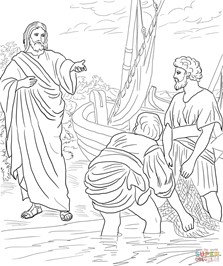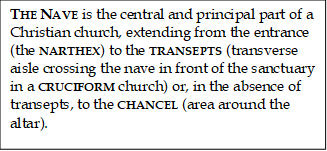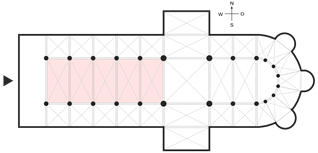Episcopal Christianity is a Way of Hearing
We have affirmed that the Holy Spirit gives us the gift of seeing: God in the infant Jesus, God in Jesus’ life and death on the cross, God in all creation, God in history, God in Bread, wine, and water. Episcopalians also believe that the same Holy Spirit bestows upon us the gift of Hearing …
The Living Word
What is the Living Word?
First, we need to understand the opposite of “Living Word,” which is “Dead Word” –truth packaged in propositions with which we can argue, agree, or disagree. In contrast, Living Word is truth manifest in an event, a story, or an encounter through which God address us and calls for repentance, revolution, or a redirection of life. The New Testament word for this change is Metanoia, which means “to turn around and go in a new direction.”
We teach that the Word of God is a Living Address which enters our hearts calling for radical change.
- The word “Address” does not mean a “street number” or a “formal lecture” but God’s passionate, invoking, calling, begging, confronting appeal to us.
- For our purposes, we should think of our “hearts” as our willing, responding, deciding selves.
This understanding of Word of God as confronting address rather than rational proposition is one way in which our teaching champions Hebrew thought over Greek thought.
- In an earlier lesson, we saw another example of the way our teaching champions Hebrew thinking over Greek thinking. Hebrew thought affirms the goodness of creation, an earth filled with the glory of God, while Greek thought sees matter as evil and therefore separates God from creation, the spiritual from the physical.
Greek thought, which would package truth in debatable propositions has often prevailed in the Christian Church throughout the centuries. The popularity of Greek thought is evident in two common ways of understanding the Bible:
God—Dictates—Bible—Human Reason—True Propositions
-
Many Christians say that the Bible was in some way dictated by God to the writers and is therefore “inerrant.” By using reason, we can deduce fundamental propositions which must be accepted:
- There are certain doctrines that we must “believe.”
- There are certain moral laws that we must obey.
- There are certain steps of “the way of salvation” that we must experience.
- There are certain doctrines that we must “believe.”
Humans—Write—Bible—Human Reason—True Propositions
-
Other Christians say that the Bible is a fallible human book. However, by using reason to get behind primitive and legendary material, we can find eternal truths valid for all time such as:
- God is the Father of all humanity.
- All humans are brothers and sisters.
- We all should follow the Golden Rule.
- God is the Father of all humanity.
Both above ways of viewing the Bible are “Greek” because both understand truth to be contained in propositions deduced by logical thought. These two ways of thinking about the Word of God represent the opposing sides in the old debate between Fundamentalists and Liberals.
- A more common debate today is between Fundamentalists and those who use historical and literary criticism—a method of searching for the sources, the literary forms, and the historical situations behind the original texts. I believe this method helps us to hear Scripture because it puts us in touch with the first readers (first listeners) and the Word which the writers, inspired by the Spirit spoke to them.
Living Word
In contrast, Episcopal thought follows a Hebrew way of thinking. Truth is the living, creative, powerful “Address” of a loving God. Truth is the Living Word which breaks into our lives, into our history, shattering old ways and creating
New Life, New Values, and New Commitment!
Living Word is the “Address” that Creates Change.





The climatic address of God’s Living Word is the event of the life, teaching, suffering, death, and resurrection of Jesus. When we hear the story, God breaks into our lives pleading …
“Give Up Your … Games … False Gods… Illusions … Vindications … Excuses.
Give up your dreams of finding wholeness and validation in your good works, your status, in what you own and consume, in your group or national identity, in your morality, in your self-fulfillment, in pleasure, in what you can do to change history.”
Through Christ, God woos us and pleads with us, “I love you. I forgive you. I want you. Trust me. Obey me. Enter the joy of my kingdom.” When we hear this call, we hear the Living Word.
 The Living Word comes as Law and Gospel. The Word exposes our “turned-in-on-self” ways and demands that we change (Law). The Word, by love, forgiveness, and the victory won on the cross (Gospel), empowers the very change which it demands. Thus, the new life is Totally a Gift.
The Living Word comes as Law and Gospel. The Word exposes our “turned-in-on-self” ways and demands that we change (Law). The Word, by love, forgiveness, and the victory won on the cross (Gospel), empowers the very change which it demands. Thus, the new life is Totally a Gift.



The manger was “human.”If it were made of wood, no doubt some boards would have been crooked and some nails would have been bent. Nevertheless, it held a divine Word for the world. The Bible, likewise, is “human.” Yet it is “divine” because …
The Bible, both Old and New Testaments, holds the living Christ who, as the Scriptures are read and proclaimed, lives as God’s address to us.
The Holy Spirit opens our ears to Hear. We believe the Living word and … Illusions are shattered—Old ways are rejected—Enemies are reconciled-—New Life is born—a family is created—and disciples heed the call … to FOLLOW ME!
We confess that the Holy Spirit opens our ears to hear the Living Word of God. The address which breaks into our lives shattering old ways of selfishness and illusion and creating in us a new way of obedient trust.
This is the Episcopal Way of Hearing.
Episcopal Liturgy
Liturgy (meaning “Work of the People’) is what we do when we gather to worship. The chief liturgy of Episcopalians is the Holy communion, the weekly Lord’s Day event when we (1) hear the reading and proclamation of Scripture and (2) act out the gospel in the ritual drama of the meal. We believe that God Acts in our words and in our ritual drama making the Gospel happen.
Our Episcopal identity is evident in our liturgy:
We are catholic.
The Holy Communion liturgy follows the form of the universal church, a form which probably goes back to the apostles:
- Scripture Reading and Preaching
- Prayers of intercession
- Confession and Forgiveness
- Peace sharing
- Offering
- Thanksgiving prayer
- Lord’s prayer
- Meal
Our catholic identity is also evident in the creeds we confess and in the hymns and prayers we use.
We are Evangelical (we spread the Good News).
The liturgy proclaims the center of our faith—God is gracious. Coming with unconditional love, mercy, and forgiveness, God gathers us to himself and sustains us in his inclusive family. This is Good News!
We are Evolving/Re-forming.
While following the catholic form, (see above) led by our Bishop and our Priest, we can change the way we sing or speak or dramatize the Tradition, if a new way will enable the liturgy to proclaim the Gospel more clearly.
Recent examples: the use of contemporary language, the inclusion of laity in liturgical functions, the ordination of women to the priesthood and the ministry of word and sacrament, the spirit of joy and the cultural diversity evident in more recent hymnals.
- Important Note: Change does not mean altering the Tradition, the ancient catholic form. We change only Conventions—the musical instruments we use, the visual arts we use, the way we speak, sing, move, and arrange our worship space.
When we gather to Worship, we hear the Living Word. We see God enfleshed. By eating and drinking we are incorporated again into Christ that we may empowered to follow the way of the cross.


The word “nave” comes from the Latin word for “ship”, navis, because people in the Middle Ages thought a nave looked like the bottom part of a ship turned upside-down. You can see the two rows of columns, and the three naves (or one nave and two aisles) between the columns, and the apse (semi-circular piece) at the other end.
The narthex is an architectural element typical of early Christian and Byzantine basilicas and churches consisting of the entrance or lobby area, located at the west end of the nave, opposite the church’s main altar. By extension, the narthex can also denote a covered porch or entrance to a building.
The many cross shapes and images in the Nave are a constant reminder that we proclaim and celebrate Christ crucified—the wisdom and power of God.
An ordained minister presides at the meal.
An assisting minister may be a lay person to remind us of the priesthood of all believers.
Others serve as readers and acolytes, special actors and actresses in the great drama.
The Choir’s function is not to perform but to lead the liturgical responses, sing special elements of the liturgy, and offer special songs of praise within the liturgy.
The Ushers smile, welcome, and help people.
The altar is the central visual object in the worship room because it is here that Christ makes himself present in the meal. The altar table is free standing to make possible a sense that we are a people gathered around Christ.
The Pulpit or reading stand is the location of the first great event in the liturgy—the reading of the lessons and the proclamation of the Good News.
- Preaching and Meal never compete. They are both Word—one verbal and the other visual. The Meal is the seeing, the tasting, the receiving of the Christ proclaimed in the sermon
Note: Although a national flag may be present in an Episcopal worship hall following local custom, it should be remembered that we gather as a part of the whole Anglican Communion and Christian Church on earth, not as members of a particular nation.
The Pascal Candle symbolizes the risen Christ and burns during the Easter Season and during Baptisms, and funerals.
The Baptismal Font is prominent tin the Nave to remind us that we are people of God by Baptism. There may be Holy Water near the entry to the Nave to remind us that we first entered the church by Baptism. We may turn toward the font for the confession of sin and absolution to remind ourselves that confession is a return to Baptism.
The Congregation is not an audience but a group of actors and actresses who take part in the Great Drama. The congregation offers Praise in Word and Song, actively Listens to the reading and preaching, shares in the Creed, the Prayers of the church, and the Confession and Forgiveness of sin, portrays the church as Family of Reconciliation by passing the Peace, and takes part in the Drama of the Gospel by offering the Gifts and sharing in the Meal.
- The Liturgy is filled with songs and prayers of Thanksgiving. Therefore, we often call the Holy Communion the Eucharist which comes from the Greek word for “Thanksgiving.”
After sharing the body of Christ, we leave the worship room (The Nave) to be the body of Christ in the world, living according to his example to bring peace and healing to all humanity. This is our
Daily Liturgy, the work of God’s holy people.
